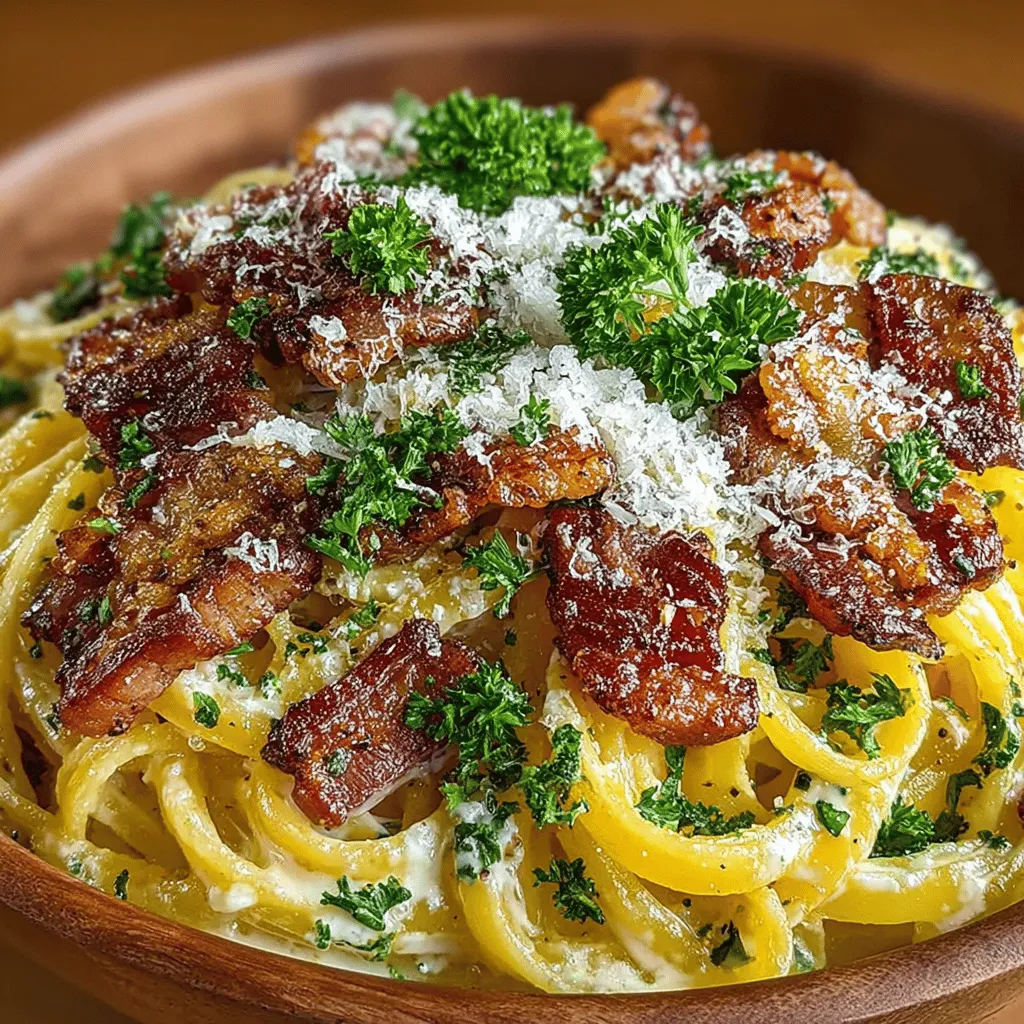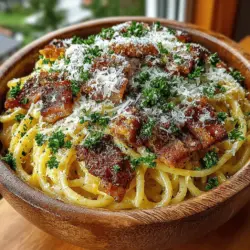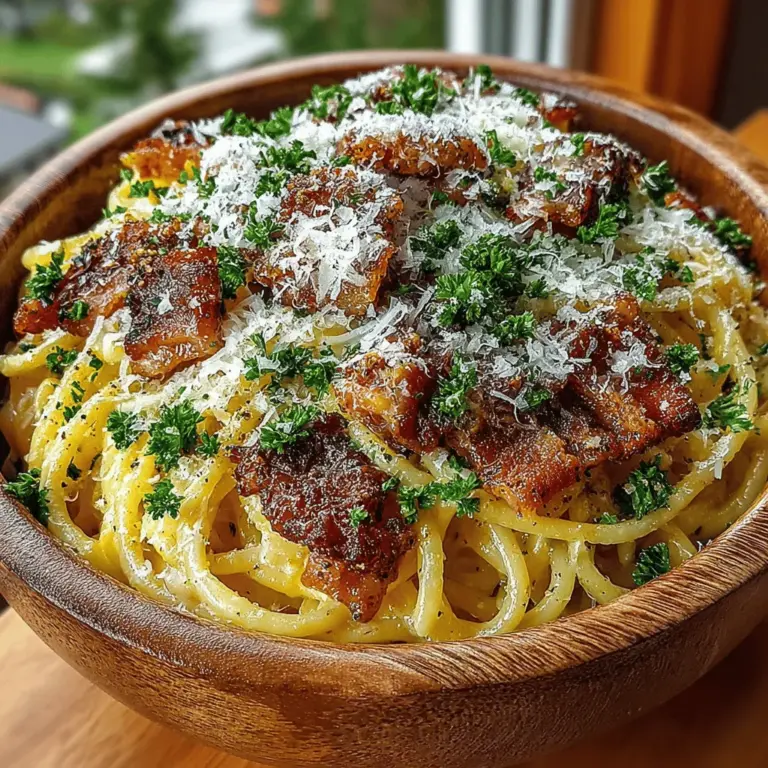Spaghetti Carbonara with Crispy Bacon: An Italian Classic
Spaghetti Carbonara is an iconic Italian dish that has captured the hearts (and stomachs) of food lovers around the globe. Originating from the Lazio region of Italy, particularly Rome, this pasta dish has gained a reputation for its rich flavors and comforting simplicity. The beauty of Carbonara lies in its ability to transform a few basic ingredients into a luxurious meal that feels both indulgent and satisfying.
The joy of cooking traditional Italian recipes at home is unparalleled. Not only do you get to enjoy the delicious results, but you also immerse yourself in a culinary tradition that has been passed down through generations. Making Spaghetti Carbonara from scratch allows you to appreciate the art of Italian cooking, where quality ingredients and straightforward techniques come together to create something truly special.
What makes Spaghetti Carbonara irresistible? The answer lies in its key ingredients: perfectly al dente spaghetti, crispy bacon (or pancetta), creamy eggs, and the sharp, salty notes of Pecorino Romano cheese. Each element plays a critical role in crafting the dish’s signature flavor, delivering a delightful balance of richness and umami that leaves you craving more.
Understanding Spaghetti Carbonara
The history of Carbonara is a fascinating one, steeped in anecdotal lore and culinary debate. While the exact origins remain unclear, many believe that the dish was created by Italian charcoal workers (the “carbonari”), which is reflected in its name. Others suggest that it was influenced by American soldiers in Italy during World War II, who combined local pasta with their rations of bacon and eggs. Regardless of its true beginnings, Carbonara has evolved over time, spawning countless variations. However, the traditional Roman version remains a beloved classic.
At its core, Spaghetti Carbonara relies on a few key ingredients that define its character:
– Spaghetti: This long, thin pasta is the classic choice for Carbonara, as its shape allows it to hold onto the creamy sauce beautifully.
– Bacon vs. Pancetta: While many recipes call for bacon, authentic Carbonara typically uses pancetta, an Italian cured meat that adds a distinct flavor profile. Understanding the nuances between these two ingredients is essential for achieving the right taste and texture.
– Pecorino Romano: This hard, salty cheese made from sheep’s milk is crucial in creating the dish’s signature creaminess and richness. It has a sharper flavor compared to Parmesan, which elevates the overall taste of the Carbonara.
Ingredients Breakdown
To make an outstanding Spaghetti Carbonara with Crispy Bacon, you’ll need to gather the following ingredients, each contributing to the dish’s depth of flavor and texture.
Spaghetti
When it comes to choosing the right pasta, spaghetti is the traditional option for Carbonara. Look for high-quality durum wheat pasta, ideally with a bronze-drawn texture that helps sauces cling better. If you want to experiment, you can also use other pasta shapes like fettuccine or bucatini, but spaghetti remains the classic choice.
Thick-Cut Bacon or Pancetta
The choice between bacon and pancetta can greatly influence the final dish. Thick-cut bacon provides a smoky flavor and crisp texture, while pancetta is saltier and has a more delicate taste. For an authentic touch, opt for pancetta, but if you prefer bacon, select a high-quality, thick-cut variety. The thickness is crucial; it ensures that the meat becomes crispy and retains its chewiness, adding a satisfying bite to the dish.
Eggs
The role of eggs in Carbonara is fundamental. They form the base of the creamy sauce that coats the spaghetti, creating a luscious texture without the need for heavy cream. Using fresh, high-quality eggs is essential. A combination of whole eggs and egg yolks will yield the richest flavor and silkiness. As you mix the eggs with the hot pasta, they will gently cook and thicken, creating that signature Carbonara sauce.
Pecorino Romano
Pecorino Romano is the cheese that truly defines Spaghetti Carbonara. Its distinctive sharpness and saltiness elevate the dish, enhancing the other flavors without overpowering them. When selecting Pecorino, look for a block that you can grate yourself; pre-grated cheese often lacks the same flavor and texture. The fresh grating will melt beautifully into the warm pasta, creating a creamy, cohesive sauce.
Garlic
While traditional Carbonara recipes often omit garlic, incorporating it can add an extra layer of flavor without overwhelming the dish. A light sauté of minced garlic can enhance the overall taste, providing a subtle aromatic note that complements the richness of the bacon and cheese.
Seasoning
The final touch to perfecting your Spaghetti Carbonara lies in seasoning. Freshly cracked black pepper is a must, adding a delightful heat that balances the creaminess of the sauce. Be cautious with salt, particularly since both pancetta and Pecorino Romano are naturally salty. Taste as you go to ensure the seasoning is just right, allowing the natural flavors of the ingredients to shine through.
Now that you understand the essential components of Spaghetti Carbonara, it’s time to roll up your sleeves and get cooking. In the next section, we will dive into the step-by-step process of preparing this beloved dish, ensuring that you achieve that perfect creamy sauce and crispy bacon every time.

Fresh Parsley
Fresh parsley is not just a garnish; it adds a vibrant splash of color and a refreshing flavor that complements the richness of spaghetti carbonara beautifully. When you sprinkle finely chopped parsley over your finished dish, it enhances the visual appeal and provides a hint of herbal freshness that balances the savory elements of bacon and cheese. Opt for flat-leaf parsley, as it offers a more robust flavor than curly parsley.
Olive Oil
While traditional carbonara recipes often rely on the fat rendered from the bacon or guanciale, a drizzle of good-quality olive oil can enhance the dish’s overall taste and texture. Use it sparingly to sauté the garlic (if you choose to include it) and to help create a smooth sauce when combining the pasta with the other ingredients. Olive oil not only adds flavor but also helps in preventing the pasta from sticking together, ensuring an even distribution of the sauce.
Step-by-Step Cooking Instructions
Boiling the Spaghetti
To achieve perfect al dente spaghetti, start by bringing a large pot of salted water to a rolling boil. The general rule is to use about 1 tablespoon of salt for every 4 quarts of water. Once the water is boiling, add your spaghetti and stir it gently to prevent it from sticking.
Cook the pasta according to the package instructions, usually around 8-10 minutes for dried spaghetti. To test for doneness, taste a strand a minute or two before the suggested cooking time; it should be firm to the bite, with a slight resistance in the center. Reserve about 1 cup of pasta cooking water before draining the spaghetti, as this starchy water can be used later to adjust the sauce’s consistency.
Cooking the Bacon
For that ideal crispy bacon, cut your bacon into small strips or lardons, which will render fat more quickly and evenly. In a large skillet over medium heat, add the bacon without overcrowding the pan. Allow it to cook undisturbed for several minutes until it begins to brown.
Once the edges are crispy, stir the bacon occasionally to ensure even cooking. This process should take about 5-7 minutes. When the bacon is perfectly crispy, remove it from the pan using a slotted spoon and place it on a plate lined with paper towels to absorb excess fat. If there’s an excessive amount of rendered fat in the pan, carefully drain some, leaving enough to coat the pasta later.
Preparing the Carbonara Sauce
The traditional carbonara sauce is a simple yet rich blend of eggs and cheese. In a mixing bowl, combine 3 large eggs with 1 cup of freshly grated Pecorino Romano cheese (or Parmesan cheese if you prefer). Whisk together until the mixture is smooth and creamy. The cheese will help thicken the sauce and add a salty, umami-rich flavor.
To ensure a silky consistency, it’s important to temper the eggs before combining them with the hot pasta. To do this, gradually add a splash of the reserved pasta water to the egg and cheese mixture while whisking continuously. This step raises the temperature of the eggs slowly, preventing them from scrambling when mixed with the hot spaghetti.
Combining Pasta and Bacon
Once your spaghetti is cooked and drained, return it to the skillet containing the residual bacon fat over low heat. Add the crispy bacon back into the pan and toss to combine. This allows the pasta to absorb the flavors of the bacon.
Next, remove the skillet from the heat to prevent the eggs from cooking too quickly. Immediately pour the egg and cheese mixture over the pasta, tossing vigorously to ensure every strand is coated. If the sauce is too thick, gradually add more reserved pasta water until you reach your desired creamy consistency.
Adding the Sauce
The key to a successful carbonara is to add the sauce at the right moment. Pour the egg and cheese mixture onto the hot pasta off the heat to avoid scrambling the eggs. Continue tossing the pasta vigorously to create a creamy sauce. The residual heat from the pasta will gently cook the eggs, creating a smooth, luscious coating.
If you notice the sauce is too thick, don’t hesitate to add a little more reserved pasta water to loosen it up. Taste and adjust the seasoning with salt and freshly cracked black pepper, as the cheese and bacon will contribute to the overall saltiness.
Serving Suggestions
To serve your spaghetti carbonara like a true Italian, use large pasta bowls or plates. Twirl a generous portion of pasta onto a fork or pasta tongs and place it in the center of the dish. Finish off with a sprinkle of freshly grated cheese, a dash of black pepper, and the chopped parsley for a pop of color.
For added flair, you can drizzle a bit of high-quality olive oil on top. Presenting your dish this way not only makes for an appetizing appearance but also elevates the overall dining experience.
Nutritional Information
Spaghetti carbonara is indulgent but can be balanced with mindful serving sizes. A standard serving of carbonara (about 1 cup) contains approximately:
– Calories: 400-600 (depending on the amount of cheese and bacon)
– Protein: 20-25g
– Carbohydrates: 50-60g
– Fat: 15-25g
While this dish is rich and satisfying, enjoying it in moderation is key. Pairing carbonara with a light, refreshing salad can help balance the meal. Incorporating more vegetables into your diet alongside this pasta dish can enhance your overall nutritional intake.
Culinary Tips for Perfecting Carbonara
Common Pitfalls in Making Carbonara
One of the most common mistakes in making carbonara is cooking the egg mixture too quickly, leading to scrambled eggs rather than a creamy sauce. Always add the egg mixture off the heat and toss quickly to create a smooth texture. Additionally, be cautious not to add too much pasta water at once; start with a small amount and gradually adjust to achieve the desired consistency.
Adjusting for Dietary Preferences
If you have dietary restrictions, there are several ways to modify this recipe. For a gluten-free option, substitute traditional spaghetti with gluten-free pasta made from rice, quinoa, or lentils. To create a dairy-free carbonara, use a plant-based alternative to eggs and cheese. Cashew cream mixed with nutritional yeast can mimic the creamy and cheesy aspects of the dish beautifully.
Flavor Enhancements
While classic carbonara is delicious as is, consider adding subtle variations to enhance the flavor. A pinch of smoked paprika can introduce a smoky undertone that pairs well with the bacon. Fresh herbs like thyme or basil can also be a lovely addition, bringing a herbal note that complements the richness of the dish. For those who enjoy a hint of heat, red pepper flakes can provide a pleasant kick.
Conclusion
Creating a classic dish like spaghetti carbonara with crispy bacon at home is a rewarding culinary experience. By paying attention to detail in every step, from selecting quality ingredients to mastering the technique, you can recreate this beloved Italian staple in your kitchen.
Don’t hesitate to experiment with the recipe, adjusting it to your taste preferences while honoring the traditional techniques that make carbonara so special. The comfort and satisfaction of savoring a homemade plate of this creamy pasta dish is truly unparalleled. Enjoy the journey of cooking, and take pride in every forkful of your delightful spaghetti carbonara!

